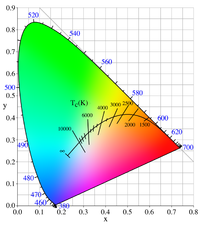
Photo from wikipedia
The temperature compensation effect strongly influences the measurement accuracy of FBG sensors. The most widely used compensation methods can be classified into three types depending on the FBG encapsulation method:… Click to show full abstract
The temperature compensation effect strongly influences the measurement accuracy of FBG sensors. The most widely used compensation methods can be classified into three types depending on the FBG encapsulation method: 1) dual-grating differential measurement for fully pasted FBGs, 2) dual-grating differential measurement for prestretched FBGs with both ends fixed, and 3) the addition of a temperature-reference FBG. In current reports, temperature compensation is performed based on the assumption that the wavelength shifts of the two FBGs are the same (or proportional to each other) and are synchronous with the temperature variation. However, because of uncertainties in workmanship and the thermal flow differences between different encapsulated FBGs, the validity of this assumption is doubtful. In this paper, the compensation characteristics of each method at different heating rates are investigated through a series of experiments and theoretical analyses. A detailed comparative analysis shows that Method 2 can be considered the optimal temperature compensation scheme in terms of both compensation accuracy and stability, whereas Method 1 is slightly inferior to Method 2. In addition, Method 3 is roughly equivalent to Method 1 and slightly inferior to Method 2 when the heating rate is <0.8 °C/min; however, when the heating rate is ≥1 °C/min, Method 3 is considerably inferior to both Method 1 and Method 2. The results indicate that the compensation effect is determined by both the FBG encapsulation method and the temperature change rate, thus revealing the deficiency of the current compensation assumption.
Journal Title: Journal of Lightwave Technology
Year Published: 2019
Link to full text (if available)
Share on Social Media: Sign Up to like & get
recommendations!